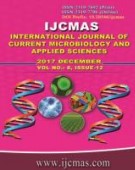


 National Academy of Agricultural Sciences (NAAS)
National Academy of Agricultural Sciences (NAAS)

|
PRINT ISSN : 2319-7692
Online ISSN : 2319-7706 Issues : 12 per year Publisher : Excellent Publishers Email : editorijcmas@gmail.com / submit@ijcmas.com Editor-in-chief: Dr.M.Prakash Index Copernicus ICV 2018: 95.39 NAAS RATING 2020: 5.38 |
Cereals are the staple foods of mankind and they provide the major portion of the energy, protein and other nutrients in the diets. Protein is an essential component required for growth, antibodies production and immunity in human beings. Screening and evaluation of protein content in 150 rice germplasm accessions was undertaken to identify protein rich germplasm. The germplasm accessions comprised of landraces from different parts of the country and world, CHIR lines, IG lines, ARB lines and RPHP lines. The results of the study revealed that total soluble protein content ranged from 7.54 g/100g to 14.54 g/100g of sample. Among 150 accessions, eight lines had recorded significantly higher protein content (>10.50 g/100g), 48 lines had registered moderate content (9.01 to 10.50 g/100g) and 94 lines had registered low protein content (< 9.00 g/100g). Cluster analysis based on available protein content revealed that, 150 accessions were grouped into two major clusters at the similarity coefficient of 2.24. Cluster I is comprised of three genotypes viz., RG1 (Mapillaisamba), RG7 (Kudaivazhai) and RG110 (Norungan) which recorded higher protein content (14.54 to 12.38g/100g) and these are landraces of Tamil Nadu. Cluster II comprised of 147 accessions that branched into three sub clusters. Sub-cluster 1 had genotypes with high protein content in the range of 10.70 to 10.96 g/100g, while sub cluster II consisted of 48 genotypes with moderate protein content in the range of 9.16 to 10.25g/100g. Finally, 94 genotypes with low protein content (7.54 to 8.71g/100g) fell in sub cluster 3. The high protein genotypes identified in this study can be potentially utilized for mapping of key genomic regions associated with protein content in rice and in biofortification programmes.
 |
 |
 |
 |
 |